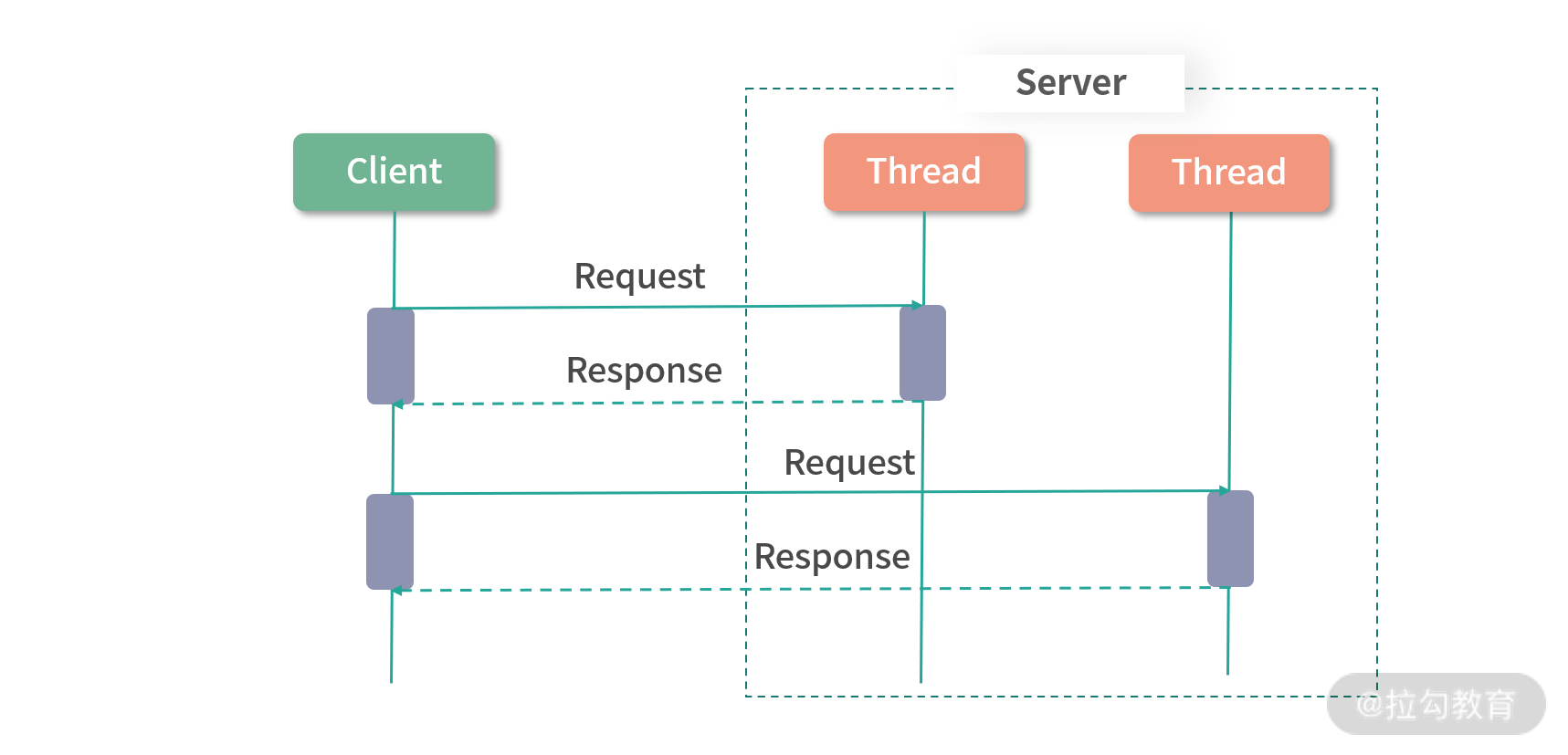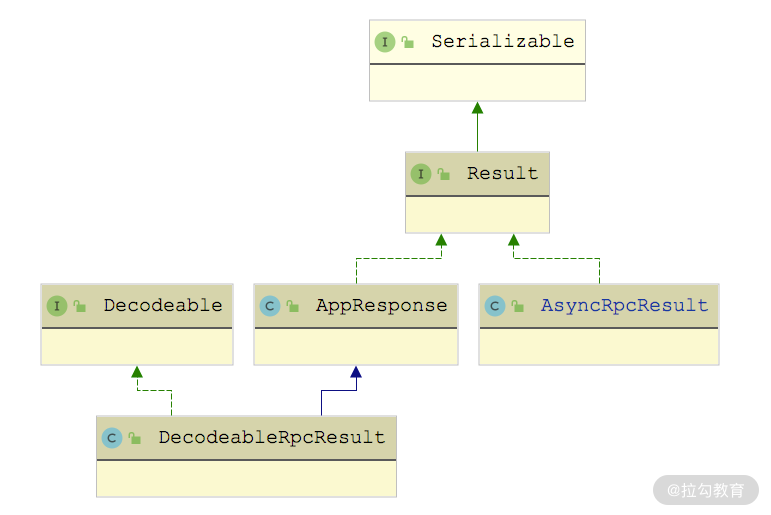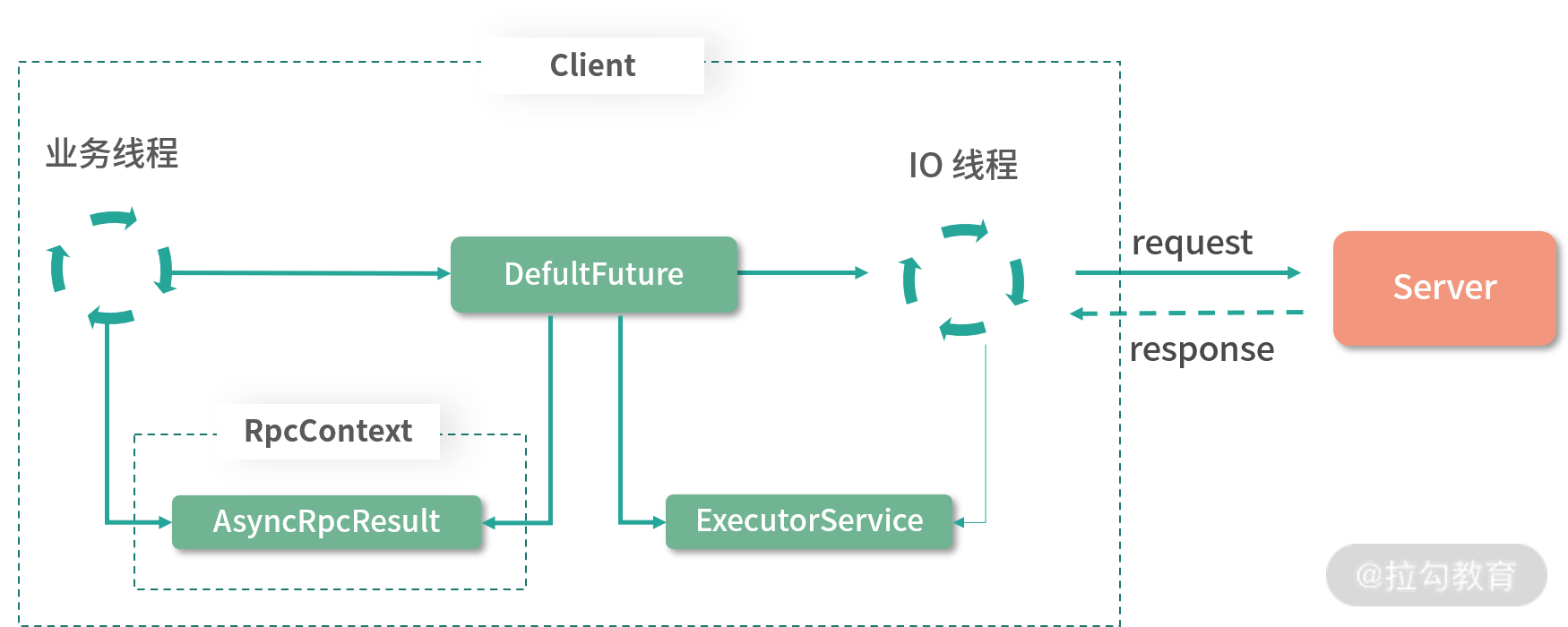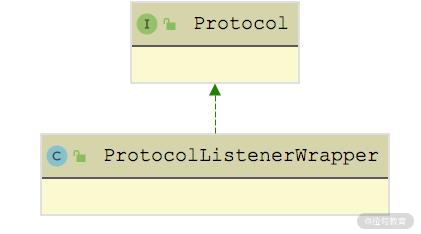27 加餐:直击 Dubbo “心脏”,带你一起探秘 Invoker(下)
关于 DubboInvoker,在发送完oneway 请求之后,会立即创建一个已完成状态的 AsyncRpcResult 对象(主要是其中的 responseFuture 是已完成状态)。这在上一课时我们已经讲解过了。
本课时我们将继续介绍 DubboInvoker 处理 twoway 请求和响应的相关实现,其中会涉及响应解码、同步/异步响应等相关内容;完成对 DubboInvoker 的分析之后,我们还会介绍 Dubbo 中与 Listener、Filter 相关的 Invoker 装饰器。
再探 DubboInvoker
那 DubboInvoker 对twoway 请求的处理又是怎样的呢?接下来我们就来重点介绍下。首先,DubboInvoker 会调用 getCallbackExecutor() 方法,根据不同的 InvokeMode 返回不同的线程池实现,代码如下:
protected ExecutorService getCallbackExecutor(URL url, Invocation inv) { ExecutorService sharedExecutor = ExtensionLoader.getExtensionLoader(ExecutorRepository.class).getDefaultExtension().getExecutor(url); if (InvokeMode.SYNC == RpcUtils.getInvokeMode(getUrl(), inv)) { return new ThreadlessExecutor(sharedExecutor); } else { return sharedExecutor; } }
InvokeMode 有三个可选值,分别是 SYNC、ASYNC 和 FUTURE。这里对于 SYNC 模式返回的线程池是 ThreadlessExecutor,至于其他两种异步模式,会根据 URL 选择对应的共享线程池。
SYNC 表示同步模式,是 Dubbo 的默认调用模式,具体含义如下图所示,客户端发送请求之后,客户端线程会阻塞等待服务端返回响应。

SYNC 调用模式图
在拿到线程池之后,DubboInvoker 就会调用 ExchangeClient.request() 方法,将 Invocation 包装成 Request 请求发送出去,同时会创建相应的 DefaultFuture 返回。注意,这里还加了一个回调,取出其中的 AppResponse 对象。AppResponse 表示的是服务端返回的具体响应,其中有三个字段。
- result(Object 类型):响应结果,也就是服务端返回的结果值,注意,这是一个业务上的结果值。例如,在我们前面第 01 课时的 Demo 示例(即 dubbo-demo 模块中的 Demo)中,Provider 端 DemoServiceImpl 返回的 “Hello Dubbo xxx” 这一串字符串。
- exception(Throwable 类型):服务端返回的异常信息。
- attachments(Map 类型):服务端返回的附加信息。
这里请求返回的 AppResponse 你可能不太熟悉,但是其子类 DecodeableRpcResult 你可能就有点眼熟了,DecodeableRpcResult 表示的是一个响应,与其对应的是 DecodeableRpcInvocation(它表示的是请求)。在第 24 课时介绍 DubboCodec 对 Dubbo 请求体的编码流程中,我们已经详细介绍过 DecodeableRpcInvocation 了,你可以回顾一下 DubboCodec 的 decodeBody() 方法,就会发现 DecodeableRpcResult 的“身影”。
1. DecodeableRpcResult
DecodeableRpcResult 解码核心流程大致如下:
- 首先,确定当前使用的序列化方式,并对字节流进行解码。
- 然后,读取一个 byte 的标志位,其可选值有六种枚举,下面我们就以其中的 RESPONSE_VALUE_WITH_ATTACHMENTS 为例进行分析。
- 标志位为 RESPONSE_VALUE_WITH_ATTACHMENTS 时,会先通过 handleValue() 方法处理返回值,其中会根据 RpcInvocation 中记录的返回值类型读取返回值,并设置到 result 字段。
- 最后,再通过 handleAttachment() 方法读取返回的附加信息,并设置到 DecodeableRpcResult 的 attachments 字段中。
public Object decode(Channel channel, InputStream input) throws IOException { // 反序列化 ObjectInput in = CodecSupport.getSerialization(channel.getUrl(), serializationType) .deserialize(channel.getUrl(), input); byte flag = in.readByte(); // 读取一个byte的标志位 // 根据标志位判断当前结果中包含的信息,并调用不同的方法进行处理 switch (flag) { case DubboCodec.RESPONSE_NULL_VALUE: break; case DubboCodec.RESPONSE_VALUE: handleValue(in); break; case DubboCodec.RESPONSE_WITH_EXCEPTION: handleException(in); break; case DubboCodec.RESPONSE_NULL_VALUE_WITH_ATTACHMENTS: handleAttachment(in); break; case DubboCodec.RESPONSE_VALUE_WITH_ATTACHMENTS: handleValue(in); handleAttachment(in); break; case DubboCodec.RESPONSE_WITH_EXCEPTION_WITH_ATTACHMENTS: default: throw new IOException(“…” ); } if (in instanceof Cleanable) { ((Cleanable) in).cleanup(); } return this; }
decode() 方法中其他分支的代码这里就不再展示了,你若感兴趣的话可以参考 DecodeableRpcResult 源码进行分析。
2. AsyncRpcResult
在 DubboInvoker 中还有一个 AsyncRpcResult 类,它表示的是一个异步的、未完成的 RPC 调用,其中会记录对应 RPC 调用的信息(例如,关联的 RpcContext 和 Invocation 对象),包括以下几个核心字段。
- responseFuture(CompletableFuture
类型):这个 responseFuture 字段与前文提到的 DefaultFuture 有紧密的联系,是 DefaultFuture 回调链上的一个 Future。后面 AsyncRpcResult 之上添加的回调,实际上都是添加到这个 Future 之上。
* storedContext、storedServerContext(RpcContext 类型):用于存储相关的 RpcContext 对象。我们知道 RpcContext 是与线程绑定的,而真正执行 AsyncRpcResult 上添加的回调方法的线程可能先后处理过多个不同的 AsyncRpcResult,所以我们需要传递并保存当前的 RpcContext。
* executor(Executor 类型):此次 RPC 调用关联的线程池。
* invocation(Invocation 类型):此次 RPC 调用关联的 Invocation 对象。
在 AsyncRpcResult 构造方法中,除了接收发送请求返回的 CompletableFuture
对象,还会将当前的 RpcContext 保存到 storedContext 和 storedServerContext 中,具体实现如下:
public AsyncRpcResult(CompletableFuture future, Invocation invocation) { this.responseFuture = future; this.invocation = invocation; this.storedContext = RpcContext.getContext(); this.storedServerContext = RpcContext.getServerContext(); }
通过 whenCompleteWithContext() 方法,我们可以为 AsyncRpcResult 添加回调方法,而这个回调方法会被包装一层并注册到 responseFuture 上,具体实现如下:
public Result whenCompleteWithContext(BiConsumer<Result, Throwable> fn) { // 在responseFuture之上注册回调 this.responseFuture = this.responseFuture.whenComplete((v, t) -> { beforeContext.accept(v, t); fn.accept(v, t); afterContext.accept(v, t); }); return this; }
这里的 beforeContext 首先会将当前线程的 RpcContext 记录到 tmpContext 中,然后将构造函数中存储的 RpcContext 设置到当前线程中,为后面的回调执行做准备;而 afterContext 则会恢复线程原有的 RpcContext。具体实现如下:
private RpcContext tmpContext; private RpcContext tmpServerContext; private BiConsumer<Result, Throwable> beforeContext = (appResponse, t) -> { // 将当前线程的 RpcContext 记录到 tmpContext 中 tmpContext = RpcContext.getContext(); tmpServerContext = RpcContext.getServerContext(); // 将构造函数中存储的 RpcContext 设置到当前线程中 RpcContext.restoreContext(storedContext); RpcContext.restoreServerContext(storedServerContext); }; private BiConsumer<Result, Throwable> afterContext = (appResponse, t) -> { // 将tmpContext中存储的RpcContext恢复到当前线程绑定的RpcContext RpcContext.restoreContext(tmpContext); RpcContext.restoreServerContext(tmpServerContext); };
这样,AsyncRpcResult 就可以处于不断地添加回调而不丢失 RpcContext 的状态。总之,AsyncRpcResult 整个就是为异步请求设计的。
在前面的分析中我们看到,RpcInvocation.InvokeMode 字段中可以指定调用为 SYNC 模式,也就是同步调用模式,那 AsyncRpcResult 这种异步设计是如何支持同步调用的呢? 在 AbstractProtocol.refer() 方法中,Dubbo 会将 DubboProtocol.protocolBindingRefer() 方法返回的 Invoker 对象(即 DubboInvoker 对象)用 AsyncToSyncInvoker 封装一层。
**AsyncToSyncInvoker 是 Invoker 的装饰器,负责将异步调用转换成同步调用**,其 invoke() 方法的核心实现如下:
public Result invoke(Invocation invocation) throws RpcException { Result asyncResult = invoker.invoke(invocation); if (InvokeMode.SYNC == ((RpcInvocation) invocation).getInvokeMode()) { // 调用get()方法,阻塞等待响应返回 asyncResult.get(Integer.MAX_VALUE, TimeUnit.MILLISECONDS); } return asyncResult; }
其实 AsyncRpcResult.get() 方法底层调用的就是 responseFuture 字段的 get() 方法,对于同步请求来说,会先调用 ThreadlessExecutor.waitAndDrain() 方法阻塞等待响应返回,具体实现如下所示:
public Result get() throws InterruptedException, ExecutionException { if (executor != null && executor instanceof ThreadlessExecutor) { // 针对ThreadlessExecutor的特殊处理,这里调用waitAndDrain()等待响应 ThreadlessExecutor threadlessExecutor = (ThreadlessExecutor) executor; threadlessExecutor.waitAndDrain(); } // 非ThreadlessExecutor线程池的场景中,则直接调用Future(最底层是DefaultFuture)的get()方法阻塞 return responseFuture.get(); }
ThreadlessExecutor 针对同步请求的优化,我们在前面的第 20 课时已经详细介绍过了,这里不再重复。
最后要说明的是,**AsyncRpcResult 实现了 Result 接口**,如下图所示:

AsyncRpcResult 继承关系图
AsyncRpcResult 对 Result 接口的实现,例如,getValue() 方法、recreate() 方法、getAttachments() 方法等,都会先调用 getAppResponse() 方法从 responseFuture 中拿到 AppResponse 对象,然后再调用其对应的方法。这里我们以 recreate() 方法为例,简单分析一下:
public Result getAppResponse() { // 省略异常处理的逻辑 if (responseFuture.isDone()) { // 检测responseFuture是否已完成 return responseFuture.get(); // 获取AppResponse } // 根据调用方法的返回值,生成默认值 return createDefaultValue(invocation); } public Object recreate() throws Throwable { RpcInvocation rpcInvocation = (RpcInvocation) invocation; if (InvokeMode.FUTURE == rpcInvocation.getInvokeMode()) { return RpcContext.getContext().getFuture(); } // 调用AppResponse.recreate()方法 return getAppResponse().recreate(); }
AppResponse.recreate() 方法实现比较简单,如下所示:
public Object recreate() throws Throwable { if (exception != null) { // 存在异常则直接抛出异常 // 省略处理堆栈信息的逻辑 throw exception; } return result; // 正常返回无异常时,直接返回result }
这里我们注意到,在 recreate() 方法中,AsyncRpcResult 会对 FUTURE 特殊处理。如果服务接口定义的返回参数是 CompletableFuture,则属于 FUTURE 模式,**FUTURE 模式也属于 Dubbo 提供的一种异步调用方式,只不过是服务端异步**。FUTURE 模式下拿到的 CompletableFuture 对象其实是在 AbstractInvoker 中塞到 RpcContext 中的,在 AbstractInvoker.invoke() 方法中有这么一段代码:
RpcContext.getContext().setFuture( new FutureAdapter(asyncResult.getResponseFuture()));
这里拿到的其实就是 AsyncRpcResult 中 responseFuture,即前面介绍的 DefaultFuture。可见,**无论是 SYNC 模式、ASYNC 模式还是 FUTURE 模式,都是围绕 DefaultFuture 展开的。**
其实,在 Dubbo 2.6.x 及之前的版本提供了一定的异步编程能力,但其异步方式存在如下一些问题:
* Future 获取方式不够直接,业务需要从 RpcContext 中手动获取。
* Future 接口无法实现自动回调,而自定义 ResponseFuture(这是 Dubbo 2.6.x 中类)虽支持回调,但支持的异步场景有限,并且还不支持 Future 间的相互协调或组合等。
* 不支持 Provider 端异步。
Dubbo 2.6.x 及之前版本中使用的 Future 是在 Java 5 中引入的,所以存在以上一些功能设计上的问题;而在 Java 8 中引入的 CompletableFuture 进一步丰富了 Future 接口,很好地解决了这些问题。**Dubbo 在 2.7.0 版本已经升级了对 Java 8 的支持,同时基于 CompletableFuture 对当前的异步功能进行了增强,弥补了上述不足。**
因为 CompletableFuture 实现了 CompletionStage 和 Future 接口,所以它还是可以像以前一样通过 get() 阻塞或者 isDone() 方法轮询的方式获得结果,这就保证了同步调用依旧可用。当然,在实际工作中,不是很建议用 get() 这样阻塞的方式来获取结果,因为这样就丢失了异步操作带来的性能提升。
另外,CompletableFuture 提供了良好的回调方法,例如,whenComplete()、whenCompleteAsync() 等方法都可以在逻辑完成后,执行该方法中添加的 action 逻辑,实现回调的逻辑。同时,CompletableFuture 很好地支持了 Future 间的相互协调或组合,例如,thenApply()、thenApplyAsync() 等方法。
正是由于 CompletableFuture 的增强,我们可以更加流畅地使用回调,不必因为等待一个响应而阻塞着调用线程,而是通过前面介绍的方法告诉 CompletableFuture 完成当前逻辑之后,就去执行某个特定的函数。在 Demo 示例(即 dubbo-demo 模块中的 Demo )中,返回 CompletableFuture 的 sayHelloAsync() 方法就是使用的 FUTURE 模式。
好了,DubboInvoker 涉及的同步调用、异步调用的原理和底层实现就介绍到这里了,我们可以通过一张流程图进行简单总结,如下所示:

DubboInvoker 核心流程图
在 Client 端发送请求时,首先会创建对应的 DefaultFuture(其中记录了请求 ID 等信息),然后依赖 Netty 的异步发送特性将请求发送到 Server 端。需要说明的是,这整个发送过程是不会阻塞任何线程的。之后,将 DefaultFuture 返回给上层,在这个返回过程中,DefaultFuture 会被封装成 AsyncRpcResult,同时也可以添加回调函数。
当 Client 端接收到响应结果的时候,会交给关联的线程池(ExecutorService)或是业务线程(使用 ThreadlessExecutor 场景)进行处理,得到 Server 返回的真正结果。拿到真正的返回结果后,会将其设置到 DefaultFuture 中,并调用 complete() 方法将其设置为完成状态。此时,就会触发前面注册在 DefaulFuture 上的回调函数,执行回调逻辑。
### Invoker 装饰器
除了上面介绍的 DubboInvoker 实现之外,Invoker 接口还有很多装饰器实现,这里重点介绍 Listener、Filter 相关的 Invoker 实现。
### 1. ListenerInvokerWrapper
在前面的第 23 课时中简单提到过 InvokerListener 接口,我们可以提供其实现来监听 refer 事件以及 destroy 事件,相应地要实现 referred() 方法以及 destroyed() 方法。
ProtocolListenerWrapper 是 Protocol 接口的实现之一,如下图所示:

ProtocolListenerWrapper 继承关系图
ProtocolListenerWrapper 本身是 Protocol 接口的装饰器,在其 export() 方法和 refer() 方法中,会分别在原有 Invoker 基础上封装一层 ListenerExporterWrapper 和 ListenerInvokerWrapper。
**ListenerInvokerWrapper 是 Invoker 的装饰器**,其构造方法参数列表中除了被修饰的 Invoker 外,还有 InvokerListener 列表,在构造方法内部会遍历整个 InvokerListener 列表,并调用每个 InvokerListener 的 referred() 方法,通知它们 Invoker 被引用的事件。核心逻辑如下:
public ListenerInvokerWrapper(Invoker invoker, List listeners) { this.invoker = invoker; // 底层被修饰的Invoker对象 this.listeners = listeners; // 监听器集合 if (CollectionUtils.isNotEmpty(listeners)) { for (InvokerListener listener : listeners) { if (listener != null) {// 在服务引用过程中触发全部InvokerListener监听器 listener.referred(invoker); } } } }
在 ListenerInvokerWrapper.destroy() 方法中,首先会调用被修饰 Invoker 对象的 destroy() 方法,之后循环调用全部 InvokerListener 的 destroyed() 方法,通知它们该 Invoker 被销毁的事件,具体实现比较简单,这里就不再展示,你若感兴趣的话可以[参考源码](https://github.com/apache/dubbo/tree/dubbo-2.7.7)进行学习。
与 InvokerListener 对应的是 ExporterListener 监听器,其实现类可以通过实现 exported() 方法和 unexported() 方法监听服务暴露事件以及取消暴露事件。
相应地,在 ProtocolListenerWrapper 的 export() 方法中也会在原有 Invoker 之上用 ListenerExporterWrapper 进行一层封装,ListenerExporterWrapper 的构造方法中会循环调用全部 ExporterListener 的 exported() 方法,通知其服务暴露的事件,核心逻辑如下所示:
public ListenerExporterWrapper(Exporter exporter, List listeners) { this.exporter = exporter; this.listeners = listeners; if (CollectionUtils.isNotEmpty(listeners)) { RuntimeException exception = null; for (ExporterListener listener : listeners) { if (listener != null) { listener.exported(this); } } } }
ListenerExporterWrapper.unexported() 方法的逻辑与上述 exported() 方法的实现基本类似,这里不再赘述。
这里介绍的 ListenerInvokerWrapper 和 ListenerExporterWrapper 都是被 @SPI 注解修饰的,我们可以提供相应的扩展实现,然后配置 SPI 文件监听这些事件。
### 2. Filter 相关的 Invoker 装饰器
Filter 接口是 Dubbo 为用户提供的一个非常重要的扩展接口,将各个 Filter 串联成 Filter 链并与 Invoker 实例相关。构造 Filter 链的核心逻辑位于 ProtocolFilterWrapper.buildInvokerChain() 方法中,ProtocolFilterWrapper 的 refer() 方法和 export() 方法都会调用该方法。
buildInvokerChain() 方法的核心逻辑如下:
* 首先会根据 URL 中携带的配置信息,确定当前激活的 Filter 扩展实现有哪些,形成 Filter 集合。
* 遍历 Filter 集合,将每个 Filter 实现封装成一个匿名 Invoker,在这个匿名 Invoker 中,会调用 Filter 的 invoke() 方法执行 Filter 的逻辑,然后由 Filter 内部的逻辑决定是否将调用传递到下一个 Filter 执行。
buildInvokerChain() 方法的具体实现如下:
private static Invoker buildInvokerChain(final Invoker invoker, String key, String group) { Invoker last = invoker; // 根据 URL 中携带的配置信息,确定当前激活的 Filter 扩展实现有哪些,形成 Filter 集合 List filters = ExtensionLoader.getExtensionLoader(Filter.class).getActivateExtension(invoker.getUrl(), key, group); if (!filters.isEmpty()) { for (int i = filters.size() - 1; i >= 0; i--) { final Filter filter = filters.get(i); final Invoker next = last; // 遍历 Filter 集合,将每个 Filter 实现封装成一个匿名 Invoker last = new Invoker() { @Override public Result invoke(Invocation invocation) throws RpcException { Result asyncResult; try { // 调用 Filter 的 invoke() 方法执行 Filter 的逻辑,然后由 Filter 内部的逻辑决定是否将调用传递到下一个 Filter 执行 asyncResult = filter.invoke(next, invocation); } catch (Exception e) { ... // 省略异常时监听器的逻辑 } finally { } return asyncResult.whenCompleteWithContext((r, t) -> { ... // 省略监听器的处理逻辑 }); } }; } } return last; }
在 Filter 接口内部还定义了一个 Listener 接口,有一些 Filter 实现会同时实现这个内部 Listener 接口,当 invoke() 方法执行正常结束时,会调用该 Listener 的 onResponse() 方法进行通知;当 invoke() 方法执行出现异常时,会调用该 Listener 的 onError() 方法进行通知。
另外,还有一个 ListenableFilter 抽象类,它继承了 Filter 接口,在原有 Filter 的基础上添加了一个 listeners 集合(ConcurrentMap 集合)用来记录一次请求需要触发的监听器。需要注意的是,在执行 invoke() 调用之前,我们可以调用 addListener() 方法添加 Filter.Listener 实例进行监听,完成一次 invoke() 方法之后,这些添加的 Filter.Listener 实例就会立即从 listeners 集合中删除,也就是说,这些 Filter.Listener 实例不会在调用之间共享。
### 总结
本课时主要介绍的是 Dubbo 中 Invoker 接口的核心实现,这也是 Dubbo 最核心的实现之一。
紧接上一课时,我们分析了 DubboInvoker 对 twoway 请求的处理逻辑,其中展开介绍了涉及的 DecodeableRpcResult 以及 AsyncRpcResult 等核心类,深入讲解了 Dubbo 的同步、异步调用实现原理,说明了 Dubbo 在 2.7.x 版本之后的相关改进。最后,我们还介绍了 Invoker 接口的几个装饰器,其中涉及用于注册监听器的 ListenerInvokerWrapper 以及 Filter 相关的 Invoker 装饰器。
下一课时,我们将深入介绍 Dubbo RPC 层中代理的相关实现。
# 参考资料
https://learn.lianglianglee.com/%e4%b8%93%e6%a0%8f/Dubbo%e6%ba%90%e7%a0%81%e8%a7%a3%e8%af%bb%e4%b8%8e%e5%ae%9e%e6%88%98-%e5%ae%8c/27%20%20%e5%8a%a0%e9%a4%90%ef%bc%9a%e7%9b%b4%e5%87%bb%20Dubbo%20%e2%80%9c%e5%bf%83%e8%84%8f%e2%80%9d%ef%bc%8c%e5%b8%a6%e4%bd%a0%e4%b8%80%e8%b5%b7%e6%8e%a2%e7%a7%98%20Invoker%ef%bc%88%e4%b8%8b%ef%bc%89.md
* any list
{:toc}

